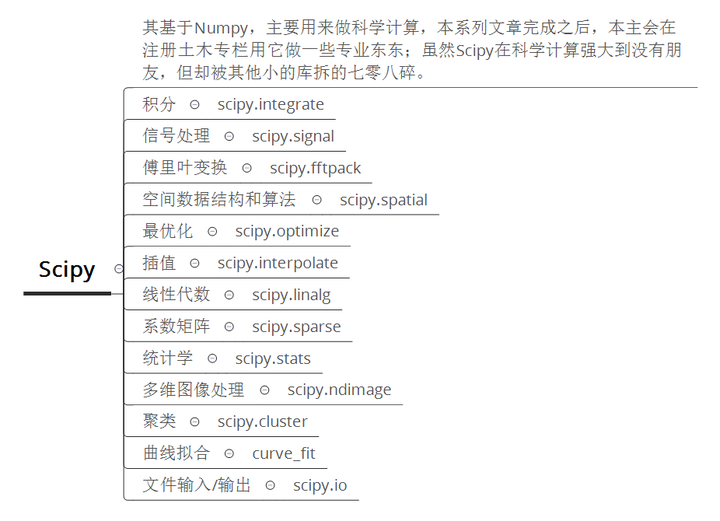Python数据分析及可视化实例之Scipy
发布时间:2021-12-03
公开文章
强大到没有朋友的科学计算库,不知道怎么介绍ta!


大牛张若愚出了厚本的《Python 科学计算》第二版
里面包罗万象,就不做搬运工了,尽快开工pandas。
来一弹在NLP自然语言处理中用到的稀疏矩阵处理:
# coding: utf-8
# # 稀疏矩阵
# `Scipy` 提供了稀疏矩阵的支持(`scipy.sparse`)。
#
# 稀疏矩阵主要使用 位置 + 值 的方法来存储矩阵的非零元素,根据存储和使用方式的不同,有如下几种类型的稀疏矩阵:
#
# 类型|描述
# ---|----
# `bsr_matrix(arg1[, shape, dtype, copy, blocksize])` | Block Sparse Row matrix
# `coo_matrix(arg1[, shape, dtype, copy])` | A sparse matrix in COOrdinate format.
# `csc_matrix(arg1[, shape, dtype, copy])` | Compressed Sparse Column matrix
# `csr_matrix(arg1[, shape, dtype, copy])` | Compressed Sparse Row matrix
# `dia_matrix(arg1[, shape, dtype, copy])` | Sparse matrix with DIAgonal storage
# `dok_matrix(arg1[, shape, dtype, copy])` | Dictionary Of Keys based sparse matrix.
# `lil_matrix(arg1[, shape, dtype, copy])` | Row-based linked list sparse matrix
#
# 在这些存储格式中:
#
# - COO 格式在构建矩阵时比较高效
# - CSC 和 CSR 格式在乘法计算时比较高效
# ## 构建稀疏矩阵
# In[1]:
from scipy.sparse import *
import numpy as np
# 创建一个空的稀疏矩阵:
# In[2]:
coo_matrix((2,3))
# 也可以使用一个已有的矩阵或数组或列表中创建新矩阵:
# In[4]:
A = coo_matrix([[1,2,0],[0,0,3],[4,0,5]])
print(A)
# 不同格式的稀疏矩阵可以相互转化:
# In[5]:
type(A)
# In[6]:
B = A.tocsr()
type(B)
# 可以转化为普通矩阵:
# In[7]:
C = A.todense()
C
# 与向量的乘法:
# In[8]:
v = np.array([1,0,-1])
A.dot(v)
# 还可以传入一个 `(data, (row, col))` 的元组来构建稀疏矩阵:
# In[9]:
I = np.array([0,3,1,0])
J = np.array([0,3,1,2])
V = np.array([4,5,7,9])
A = coo_matrix((V,(I,J)),shape=(4,4))
# In[11]:
print(A)
# COO 格式的稀疏矩阵在构建的时候只是简单的将坐标和值加到后面,对于重复的坐标不进行处理:
# In[13]:
I = np.array([0,0,1,3,1,0,0])
J = np.array([0,2,1,3,1,0,0])
V = np.array([1,1,1,1,1,1,1])
B = coo_matrix((V,(I,J)),shape=(4,4))
print(B)
# 转换成 CSR 格式会自动将相同坐标的值合并:
# In[15]:
C = B.tocsr()
print(C)
# ## 求解微分方程
# In[16]:
from scipy.sparse import lil_matrix
from scipy.sparse.linalg import spsolve
from numpy.linalg import solve, norm
from numpy.random import rand
# 构建 `1000 x 1000` 的稀疏矩阵:
# In[17]:
A = lil_matrix((1000, 1000))
A[0, :100] = rand(100)
A[1, 100:200] = A[0, :100]
A.setdiag(rand(1000))
# 转化为 CSR 之后,用 `spsolve` 求解 $Ax=b$:
# In[18]:
A = A.tocsr()
b = rand(1000)
x = spsolve(A, b)
# 转化成正常数组之后求解:
# In[19]:
x_ = solve(A.toarray(), b)
# 查看误差:
# In[20]:
err = norm(x-x_)
err
# ## sparse.find 函数
# 返回一个三元组,表示稀疏矩阵中非零元素的 `(row, col, value)`:
# In[22]:
from scipy import sparse
row, col, val = sparse.find(C)
print(row, col, val)
# ## sparse.issparse 函数
# 查看一个对象是否为稀疏矩阵:
# In[23]:
sparse.issparse(B)
# 或者
# In[24]:
sparse.isspmatrix(B.todense())
# 还可以查询是否为指定格式的稀疏矩阵:
# In[25]:
sparse.isspmatrix_coo(B)
# In[26]:
sparse.isspmatrix_csr(B)